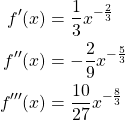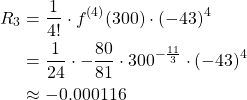42 Taylor Series
A Taylor Series is a series (see Part I: Chapter 7) that allows us to approximate the value of a function ![]() at a specific
at a specific ![]() using the derivatives (see Part I: Chapter 2) of
using the derivatives (see Part I: Chapter 2) of ![]() and one other
and one other ![]() value [9]. The general form is given by Hiestand as follows [9].
value [9]. The general form is given by Hiestand as follows [9].
![]()
We have some freedom with this method in that we get to choose ![]() and
and ![]() . However, our decisions for these values will affect the accuracy of the final approximation. First,
. However, our decisions for these values will affect the accuracy of the final approximation. First, ![]() should be chosen so that it is not far from
should be chosen so that it is not far from ![]() . The farther
. The farther ![]() is from
is from ![]() , the less accurate the approximation will be [9]. Second, the larger
, the less accurate the approximation will be [9]. Second, the larger ![]() is, the more accurate the approximation will be [9]. However, the larger
is, the more accurate the approximation will be [9]. However, the larger ![]() is, the more complicated and time-consuming the computation, especially when doing it by hand. So, we want to choose
is, the more complicated and time-consuming the computation, especially when doing it by hand. So, we want to choose ![]() small enough that the problem is not too long and complicated but large enough that the approximation is fairly accurate.
small enough that the problem is not too long and complicated but large enough that the approximation is fairly accurate.
![]() is known as the remainder term and is essentially the error between the exact value and approximated value of
is known as the remainder term and is essentially the error between the exact value and approximated value of ![]() . If the exact value is known,
. If the exact value is known, ![]() can easily be calculated by subtracting the approximate value from the exact value. But usually, the exact value is not known. (If we know the exact value, there is not much of a point in using the Taylor series in the first place.) So, there is a formula for calculating
can easily be calculated by subtracting the approximate value from the exact value. But usually, the exact value is not known. (If we know the exact value, there is not much of a point in using the Taylor series in the first place.) So, there is a formula for calculating ![]() which is given by Hiestand as follows [9].
which is given by Hiestand as follows [9].
(1) ![]()
![]() looks just like the next term in the series if we were to go past
looks just like the next term in the series if we were to go past ![]() with one key difference, the
with one key difference, the ![]() th+1 derivative is evaluated at
th+1 derivative is evaluated at ![]() rather than
rather than ![]() . We want to choose
. We want to choose ![]() such that
such that ![]() and the absolute value of
and the absolute value of ![]() is as large as possible. This is known as bounding the error [9]. If we choose
is as large as possible. This is known as bounding the error [9]. If we choose ![]() in this way, we will have
in this way, we will have ![]() equal to the largest possible error. In other words, we have found the worst case scenario.
equal to the largest possible error. In other words, we have found the worst case scenario.
We are now going to go through an example I completed for this paper that comes from Hiestand [9].
Let
- Develop a Taylor series through the third derivative term for this function.
- Use your series to estimate the cube root of 300 by expanding about
 .
. - Bound the error of your estimate and compare it to the true error.
Solution
We have that

Substituting our derivatives into the Taylor Series equation above, we have the following:
![]()
Next, we estimate the cube root of ![]() by expanding about
by expanding about ![]() by substituting these values into
by substituting these values into ![]() .
.

Finally, we need to bound the error of our estimate and compare it to the true error. The fourth derivative of our function evaluated at ![]() is
is
![]()
The value for ![]() between 300 and 343 that gives us the largest absolute value of
between 300 and 343 that gives us the largest absolute value of ![]() is
is ![]() . Substituting into equation 1 above, we have
. Substituting into equation 1 above, we have

The exact error is
![]()
Therefore, we have that
![]()
It makes sense that the actual error is less than ![]() since we chose
since we chose ![]() such that
such that ![]() would be the biggest possible error.
would be the biggest possible error.
This is the process of approximating the output of a function along with the error using a Taylor series. In our next section, we will approximate an integral using the Trapezoid Rule.
